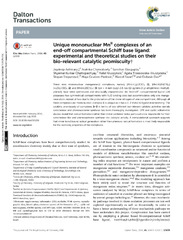Приказ основних података о документу
Unique mononuclear Mn-II complexes of an end-off compartmental Schiff base ligand: experimental and theoretical studies on their bio-relevant catalytic promiscuity
| dc.creator | Adhikary, Jaydeep | |
| dc.creator | Chakraborty, Aratrika | |
| dc.creator | Dasgupta, Sanchari | |
| dc.creator | Chattopadhyay, Shyamal Kumar | |
| dc.creator | Kruszynski, Rafal | |
| dc.creator | Trzesowska-Kruszynska, Agata | |
| dc.creator | Stepanović, Stepan | |
| dc.creator | Gruden-Pavlović, Maja | |
| dc.creator | Swart, Marcel | |
| dc.creator | Das, Debasis | |
| dc.date.accessioned | 2018-11-22T00:36:31Z | |
| dc.date.available | 2018-11-22T00:36:31Z | |
| dc.date.issued | 2016 | |
| dc.identifier.issn | 1477-9226 | |
| dc.identifier.uri | https://cherry.chem.bg.ac.rs/handle/123456789/2294 | |
| dc.description.abstract | Three new mononuclear manganese(II) complexes, namely [Mn(HL)(2)]center dot 2ClO(4) (1), [Mn(HL)(N(CN)(2)) (H2O)(2)]center dot ClO4 (2) and [Mn(HL)(SCN)(2)] (3) [LH = 4-tert-butyl-2,6-bis-[(2-pyridin-2-yl-ethylimino)-methyl]-phenol], have been synthesized and structurally characterized. An "end-off" compartmental ligand (LH) possesses two symmetrical compartments with N2O binding sites but accommodates only one manganese atom instead of two due to the protonation of the imine nitrogen of one compartment. Although all three complexes are mononuclear, complex 1 is unique as it has a 1 : 2 metal to ligand stoichiometry. The catalytic promiscuity of complexes 1-3 in terms of two different bio-relevant catalytic activities namely catecholase and phenoxazinone synthase has been thoroughly investigated. EPR and cyclic voltametric studies reveal that radical formation rather than metal centered redox participation is responsible for their catecholase-like and phenoxazinone synthase-like catalytic activity. A computational approach suggests that imine bond bound radical generation rather than phenoxo radical formation is most likely responsible for the oxidizing properties of the complexes. | en |
| dc.publisher | Royal Soc Chemistry, Cambridge | |
| dc.relation | ICREA | |
| dc.rights | openAccess | |
| dc.rights.uri | https://creativecommons.org/licenses/by-nc/4.0/ | |
| dc.source | Dalton Transactions | |
| dc.title | Unique mononuclear Mn-II complexes of an end-off compartmental Schiff base ligand: experimental and theoretical studies on their bio-relevant catalytic promiscuity | en |
| dc.type | article | |
| dc.rights.license | BY-NC | |
| dcterms.abstract | Крусзyнски, Рафал; Aдхикарy, Јаyдееп; Цхакрабортy, Aратрика; Дасгупта, Санцхари; Груден-Павловић, Маја; Сwарт, Марцел; Степановиц, Степан; Цхаттопадхyаy, Схyамал Кумар; Трзесоwска-Крусзyнска, Aгата; Дас, Дебасис; | |
| dc.citation.volume | 45 | |
| dc.citation.issue | 31 | |
| dc.citation.spage | 12409 | |
| dc.citation.epage | 12422 | |
| dc.identifier.wos | 000381480900019 | |
| dc.identifier.doi | 10.1039/c6dt00625f | |
| dc.citation.other | 45(31): 12409-12422 | |
| dc.citation.rank | M22 | |
| dc.identifier.pmid | 27430642 | |
| dc.description.other | Supplementary material: [http://cherry.chem.bg.ac.rs/handle/123456789/3657] | |
| dc.type.version | publishedVersion | |
| dc.identifier.scopus | 2-s2.0-84982663415 | |
| dc.identifier.fulltext | https://cherry.chem.bg.ac.rs/bitstream/id/9280/2292.pdf |


